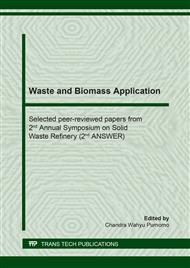p.40
p.47
p.53
p.61
p.67
p.72
p.78
p.84
p.90
Quality Improvement of Recycled Paper with Extracted Xylan from Corncobs
Abstract:
Several Indonesian paper mills utilize used paper as feedstock as the price is much cheaper and abundant availability, but the strength of the paper product tends to decrease. Xylan which is extracted from corncobs is a potential additive for upgrading the quality by modifying the fibre surface. This research studies the effect of sodium hydroxide concentration for extraction to produce an acceptable strength of paper product. The extraction process is at temperature of 90°C for 2 hours in a stirred tank reactor and the xylan product is deposited with 10 N acetic acid at pH of 4.5 - 5.0. Using 16% of NaOH concentration, the extraction produces 21.82% yield of xylan. With addition of this xylan product at mass ratio between xylan and corncobs of 5% increases 30.1% of the tensile strength and 31.83% of the tire strength. The optimum concentration of the use of NaOH in xylan extraction was at 16% NaOH with the largest xylan yield obtained at 21.82%.
Info:
Periodical:
Pages:
67-71
Citation:
Online since:
June 2020
Authors:
Keywords:
Price:
Сopyright:
© 2020 Trans Tech Publications Ltd. All Rights Reserved
Share:
Citation:


